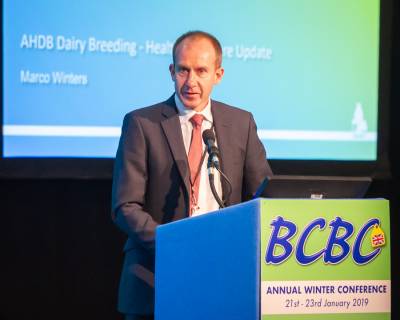
Conference delegates received an update on the topic of inbreeding in the UK dairy herd, covering national trends, tools available to manage inbreeding and latest research.
The workshop began with a review of the current inbreeding trends of the major UK dairy breeds. All but two breeds have been steadily increasing in inbreeding over the years, with Holstein pedigree females the highest on average at around 5% in the most recent year of birth. Although Holsteins are continuing to increase, the rate of increase has slowed since the mid-90s which is a positive trend. By keeping the rate of inbreeding to a minimum, natural selection removes harmful recessives over generations, ensuring favourable genetic gains and healthy animals.
Next, the results and conclusion of an SRUC study investigating the effect of inbreeding on animal performance were covered. The analysis showed that the effect of inbreeding was non-linear with inbreeding depression having a negligible effect on the example PTA (milk kg) when below 5%. The study concluded that the effect on individual PTAs were similar to other country findings and relating this back to the UK economic index, for every 1% increase in inbreeding above 5% we would expect approximately 10 £PLI to be lost in the resulting progeny due to inbreeding depression.
The final discussion covered current and new tools to help monitor and manage inbreeding. Current tools and methods available from AHDB discussed were;
• Herd Genetic Report to monitor herd inbreeding
• Inbreeding Checker to manage short-term inbreeding in the next generation
• Using a variety of bloodlines to manage long-term inbreeding
UK genomic inbreeding figures will be available for genotyped animals from AHDB Dairy in the coming year. This will give a more accurate estimate of how inbred an animal is by measuring whether two copies of a ‘gene’ are inherited as opposed to pedigree inbreeding, which is a probability that this will happen.
Once UK genomic inbreeding figures are available to the UK dairy industry these will be incorporated into the AHDB Inbreeding Checker to manage future matings, along with
the other proposed updates;
• Rather than control level of inbreeding by measuring against an absolute value (6.25%), the tool will be used to control rate of inbreeding change. This will give a positive or negative value. Unsafe matings will be indicated as those with an increase in inbreeding above a threshold, currently set a +1% increase.
• To control long term inbreeding, an additional step will be added to the tool once potential sires have been selected to use on the females. The tool will indicate if these bulls are closely related, encouraging the user to consider a variety of bloodlines in their choice of mating sires.
• Functional updates fed back to the AHDB Animal Genetics team from farmers and regular users of the tool will also be incorporated.
If you would like to sign up for a Herd Genetic Report please contact Dairy.Breeding.Evaluations@ahdb.org.uk with your milk recording number, trading name and address. Please note you must be fully milk recording with NMR, CIS, Dale Farm or QMMS to qualify for a Herd Genetic Report.